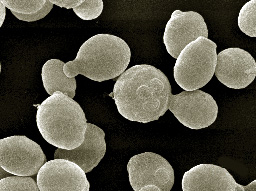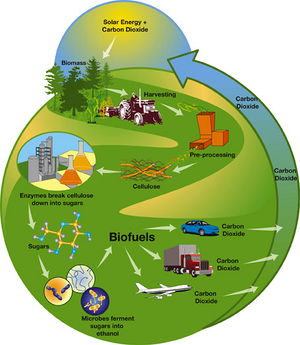Pichia stipitis: Difference between revisions
| Line 15: | Line 15: | ||
==Description and Significance== | ==Description and Significance== | ||
The fungus ''p. Stipitis'' is a yeast from the xylose fermenting clade of the ''Schefferomyces'' genus. As with most members of the ''Saccharomycetales'' order a single ''p. Stipitis'' individual has a size of 3 to 5 µm in diameter. Budding from asexual reproduction may cause deviation from the usual spherical or ellipsoidal shape of an individual. Under study it has been noted ''p. Stipitis'' exhibits a cream-colored, smooth-shaped colony [5]. A suitable habitat for ''p. Stipitis'' includes damp or wet areas rich in organic biomass. Hardwood forests or areas high in agricultural waste are common environments. Temperatures at which growth occurs are 25°C to 37°C with budding most commonly occurring at 25°C. It has been noted growth ceases at temperatures around 40°C to 45°C. | The fungus ''p. Stipitis'' is a yeast from the xylose fermenting clade of the ''Schefferomyces'' genus. As with most members of the ''Saccharomycetales'' order a single ''p. Stipitis'' individual has a size of 3 to 5 µm in diameter. Budding from asexual reproduction may cause deviation from the usual spherical or ellipsoidal shape of an individual. Under study it has been noted ''p. Stipitis'' exhibits a cream-colored, smooth-shaped colony [5]. A suitable habitat for ''p. Stipitis'' includes damp or wet areas rich in organic biomass [8]. Hardwood forests or areas high in agricultural waste are common environments. Temperatures at which growth occurs are 25°C to 37°C with budding most commonly occurring at 25°C. It has been noted growth ceases at temperatures around 40°C to 45°C [5]. | ||
The significance of ''p. Stipitis'' to industrial-related purposes comes from the ability to ferment the sugar, xylose. Degrading biomass to ethanol at high yields in respect to other ethanol-producing microorganisms has made ''p. Stipitis'' an important constituent of the alternative fuel and bioenergy industries. | The significance of ''p. Stipitis'' to industrial-related purposes comes from the ability to ferment the sugar, xylose. Degrading biomass to ethanol at high yields in respect to other ethanol-producing microorganisms has made ''p. Stipitis'' an important constituent of the alternative fuel and bioenergy industries. | ||
Revision as of 03:44, 20 April 2011
Classification

Eukarya; Fungi/Metazoa; Fungi; Dikarya; Ascomycota; Saccharomycotina; Saccharomycetes; Saccharomycetales; Debaryomycetaceae; Scheffersomyces
Species
Scheffersomyces Stipitis
Description and Significance
The fungus p. Stipitis is a yeast from the xylose fermenting clade of the Schefferomyces genus. As with most members of the Saccharomycetales order a single p. Stipitis individual has a size of 3 to 5 µm in diameter. Budding from asexual reproduction may cause deviation from the usual spherical or ellipsoidal shape of an individual. Under study it has been noted p. Stipitis exhibits a cream-colored, smooth-shaped colony [5]. A suitable habitat for p. Stipitis includes damp or wet areas rich in organic biomass [8]. Hardwood forests or areas high in agricultural waste are common environments. Temperatures at which growth occurs are 25°C to 37°C with budding most commonly occurring at 25°C. It has been noted growth ceases at temperatures around 40°C to 45°C [5].
The significance of p. Stipitis to industrial-related purposes comes from the ability to ferment the sugar, xylose. Degrading biomass to ethanol at high yields in respect to other ethanol-producing microorganisms has made p. Stipitis an important constituent of the alternative fuel and bioenergy industries.
Describe the appearance, habitat, etc. of the organism, and why you think it is important.
Genome Structure
Describe the size and content of the genome. How many chromosomes? Circular or linear? Other interesting features? What is known about its sequence?
Cell Structure, Metabolism and Life Cycle
Interesting features of cell structure; how it gains energy; what important molecules it produces.
Ecology and Pathogenesis

Habitat; symbiosis; biogeochemical significance; contributions to environment.
If relevant, how does this organism cause disease? Human, animal, plant hosts? Virulence factors, as well as patient symptoms.
References
[1] [National Center for Biotechnology Information. (2011). Taxonomy Browser. Retrieved Apr 2011, from NBCI: http://www.ncbi.nlm.nih.gov/Taxonomy/Browser/wwwtax.cgi?id=4924]
[2] [Haeng Cho, D. et al. (2010). "Ethanol production from acid hydrolysates based on the construction and demolition wood waste using Pichia stipitis." Bioresource Technology. Volume 102. p. 4439-4443.]
[3] [NBCI. (2011, Jan). Taxonomy Browser. Retrieved feb 2011, from NBCI: www.fdinodsin.com]
[4] [Suh, S., et al. (2004). "The beetle gut : a hyperdiverse source of novel yeasts". The British Mycological Society. Volume 109. p. 261-265.]
[5] [International Mycological Association. (2011). Yeast Species Database. Retrieved Apr 2011, from MycoBank: http://www.mycobank.org/yeast/BioloMICS.aspx?Link=T&DB=0&Table=0&Descr=Pichia%20stipitis&Fields=All&ExactMatch=T]
[6] [Suh, C., Marshall J., McHugh, J. V., Blackwell, M. (2003). "Wood ingestion by passalid beetles in the presence of xylose-fermenting gut yeasts". Molecular Ecology. Volume 12. p. 3137-3145. http://si-pddr.si.edu/jspui/bitstream/10088/6710/1/Suh_Marshall_McHugh_and_Blackwell.pdf]
[7] [Joint Genome Institute. (2011). Pichia Stipitis v2.0. Retrieved Apr 2011, from JGI: http://genome.jgi-psf.org/Picst3/Picst3.home.html]
[8] Blackwell, Meredith, Cletus P. Kurtzman, Marc-André Lachance, and Sung-Oui Suh. 2009. Saccharomycotina. Saccharomycetales. Version 22 January 2009. http://tolweb.org/Saccharomycetales/29043/2009.01.22 in The Tree of Life Web Project, http://tolweb.org/]
Author
Page authored by Josh Wolter and John Wright, students of Prof. Jay Lennon at Michigan State University.
<-- Do not remove this line-->Genus Scheffersomyces
